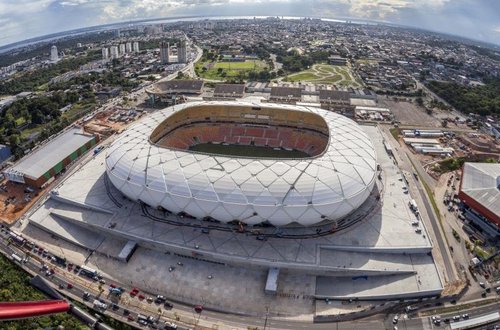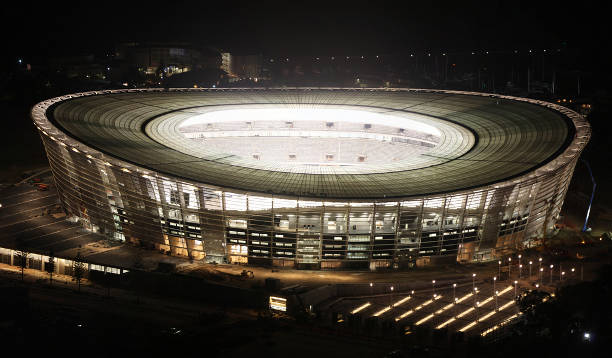Here's What Happened To Football Stadiums After Hosting World Cup Matches
They're underwhelming to say the least.
Another World Cup, another bunch of controversial decisions made on stadiums that host its matches
Take a look at the historic Ekaterinburg Arena, which was one of the world's most important arenas for speed skating in the 20th century.
CBS Sports reported that an additional 12,000 seats were temporarily "added" to the stadium, as demanded by FIFA. Nonetheless, it will not be used beyond the group stage in the World Cup, according to Telegraph.
Here's how the "addition" looks like:
Nonetheless, the Ekaterinburg stadium is considerably lucky, as it is the host to FC Ural Yekaterinburg, a top-tier football club in Russia.
Deutsche Welle reported previously that seven out of the 11 stadiums built for the Russia 2018 World Cup do not host clubs that play in the country's top flight football league.
However, those stadiums have to be burdened by operational costs from somewhere between RUB200 to RUB500 million (approximately RM12.6 to RM31.5 million), despite drawing crowds of 1,000 to 5,000 regularly for home games.
Russia's stadium woes are not news, as proven in Brazil and South Africa
Deutsche Welle reported that previous World Cup hosts such as Brazil and South Africa faced problems like those Russia is confronting now.
In the case of South Africa, the absence of fans at home games caused its World Cup stadiums to struggle with sustaining themselves financially, according to The Guardian.
NPR reported José Cruz, a sports reporter living in Brasilia, as saying that many of the stadiums in Brazil "have become a mark of shame" since the end of the 2014 World Cup.
"The World Cup is over, (but) we are suffering with everything that came after," Cruz added.
1. Estadio Nacional de Brasília Mané Garrincha, Brasília (Brazil)
After being used for seven World Cup games in 2014, the most expensive stadium built for the Brazil 2014 World Cup is now being used as a bus parking lot.
The 70,000-seat stadium cost taxpayers over USD800 million (approximately RM3.2 billion) to build.
This was the stadium that hosted the third-place playoff between Brazil and the Netherlands in the last World Cup.
2. Arena da Amazônia, Manaus (Brazil)
The remote stadium, which the Brazilian government paid an estimated USD220 to USD300 million (approximately RM876 million to RM1.2 billion) for, was only used for four matches in the Brazil 2014 World Cup. Three workers died while the stadium was in construction.
However, the stadium is now so underused that it took in only USD180,000 (approximately RM717,000) in the first four months of 2016, but spent USD560,000 (approximately RM2.3 million) in operating costs.
According to NPR, it has been sold to the private sector despite being built largely with public funds.
3. Arena das Dunas, Natal (Brazil)
NPR reported that this stadium, which hosted four matches during the Brazil 2014 World Cup, is trying to make money by hosting weddings and kids' parties, but to little success.
The private company which the stadium was sold to had put it up for sale again, as it had problems with cash flow after being involved in Brazil's state oil scandal.
4. Cape Town Stadium, Cape Town (South Africa)
"This (stadium) is available for private functions, birthday parties, weddings, and anniversaries," The Globe and Mail reported a tour guide as cheerfully telling visitors about the Cape Town Stadium in 2014.
Being one of Africa's most beautiful stadiums, the Cape Town Stadium, which cost USD536 million (approximately RM2.1 billion) to build, hosted eight matches in the 2010 World Cup.
However, it is now reportedly losing an estimated USD6 million to USD10 million (approximately RM24 million to RM40 million) annually, despite hosting occasional concerts.
5. Moses Mabhida Stadium, Durban (South Africa)
The Moses Mabhida Stadium hosted seven World Cup matches in 2010. However, after costing South Africa USD380 million (RM1.5 billion) to build, the stadium suffered from a deficit of R151 million in South African currency (approximately RM44.8 million) in 2012/2013.
Its operational cost, including maintenance, is also a whooping R88.5 million (approximately RM26.3 million) per year.
Durban city treasurer, Krish Kumar admitted previously that the stadium had not made profit since it was built, according to Times Live. Nonetheless, he stressed that the stadium could make money with its attractions: sky car, bungee-jumping facility, and restaurants.
These stadiums are living proof that hosting the World Cup entails short-lived economic benefits, and host countries are left scrapping for ways to not lose money
The stadiums, among others, represent the unnecessary spending and economic burden that comes along with hosting FIFA's marquee event.
John Vrooman, a sports economics professor told Pacific Standard that the optimistic views of economic benefit for World Cup host countries, such as increased tourism and jobs, are evidently "self-promotion schemes" designed to justify state money for the private business of professional football.
"Essentially, every economic study shows that stadiums are a terrible economic investment," Victor Matheson, an economics and accounting professor, was quoted as saying by Pacific Standard.




